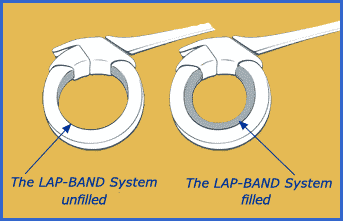With the LAP-BAND System, the band can be adjusted to meet your specific needs. That is one of its more attractive aspects. This feature allows you and your surgeon to find the right level of restriction for YOU!
When first placing it, your surgeon usually leaves the band empty or only partially inflated. This lets you get acquainted with your band during the first few weeks after surgery. It also lets healing occur around the new band site.

These first few weeks are a critical time. You need to avoid vomiting. You also need to avoid putting pressure on your new small stomach above the band. The first time the band is adjusted is usually 4 to 6 weeks after your surgery. The exact time will vary. You and your surgeon will decide when the right time is for your band adjustment. To determine how ready you are for a band adjustment, your surgeon will consider:
Being able to adjust the LAP-BAND System gives you and your surgeon control. If the band is too tight, your surgeon can "loosen" it by taking out some of the fluid. If the band is too loose, your surgeon can tighten it. Your surgeon does this by injecting fluid. Only a clinician trained and authorized by BioEnterics can adjust your band. Never let an untrained clinician do it. Never let a non-medical person do it. And never try to adjust your own band. You could cause adverse reactions for you. You could also damage your band.
| Important | ||
|
Adjustments are done either in the hospital or in a doctor's office that has x-ray equipment (fluoroscopy). The clinician may use fluoroscopy to assist in locating the access port. The surgeon may also use it to guide the needle into the port and to view inserting the needle. It is also used after the band has been adjusted to evaluate your pouch size and stoma size.
To get the best results, you may need more than one adjustment. Each one will range from 1/2 cc to 2 cc of fluid. The most the band can hold is 4 cc. The exact amount of fluid required to make the stoma the right size is unique for each person. An ideal "fill" should be just tight enough to let you gradually lose weight. That means you should still be able to eat enough to get the nutrients that you need while still reducing the over-all amount you can eat.
The LAP BAND System is meant to offer you a way to obtain steady and safe weight loss. Don't be in a hurry to have an adjustment before you're ready. To work, the band needs your participation. Your success will depend on YOU and on the partnership between you and your clinicians.